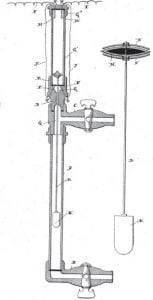Float level switches historical introduction
If the level measurement, especially for meteorological purposes seems to date back to the 4th or 5th century BC in India, the development of steam boilers for locomotives and low pressure steam boilers for central heating in the first quarter of the 19th century, has quickly revealed the indispensable requirement to control the water level.

Range of level detection devices for boilers and steam engines, 1851
 |
 |
| Joseph Dilks, US patent 7808, December 1850, float level indicator with steam alarm whistle | Mac Dermott, US patent 487634, December 1892, vertical float level device with minimum and maximum electrical contact. |
Quickly some of these devices were designed to actuate an electrical contact.
The Reed switch invention in 1936 and its mass production in the 1960s enabled the miniaturization of level switches, which are now used in many electrical appliances applications.
JPC level switches are constructed according to the technology of floats actuating an electrical contact. If the level changes, the movement of the float, which follows the variation of the position of the water surface, actuates an electrical contact. This contact is usually provided by a reed switch (Also known by the acronym ILS in French), but can also be a micro-switch.
